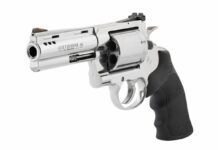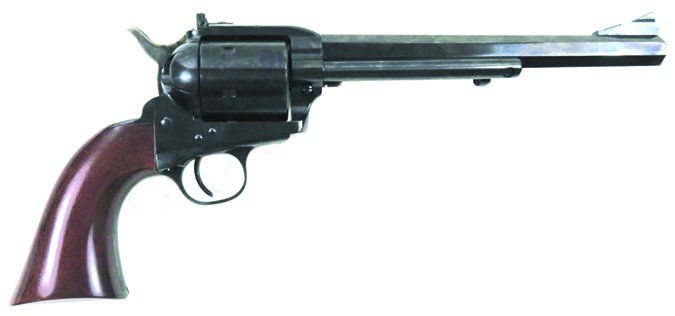
While the 45 Long Colt could be considered big medicine in a single-action revolver, single-action revolvers chambered in 44 Magnum really up the ante. The 44 Magnum is a substantial cartridge, so a substantial and strong revolver is required to fire that round. We took a look at three single-action revolvers chambered in 44 Magnum — the EAA Bounty Hunter, Cimarron’s Bad Boy, and the BFR Short Cylinder housed under the Magnum Research (Kahr) name — and found all three of these powerful revolvers had good attributes, managed recoil well without causing carpal-tunnel syndrome, and were accurate.
Range Data
| 44 Special Hornady Critical Defense 165-gr. FTX | EAA Bounty Hunter | BFR Short Cylinder | Cimarron Bad Boy |
| Average velocity | 960 fps | 1183 fps | 1143 fps |
| Muzzle energy | 338 ft.-lbs. | 513 ft.-lbs. | 479 ft.-lbs. |
| Smallest group | 1 in. | 1.2 in. | 0.9 in. |
| Average group | 2 in. | 2.2 in. | 2.4 in. |
| 44 Magnum Black Hills 240-gr. JHP | |||
| Average velocity | 961 fps | 1239 fps | 1084 fps |
| Muzzle energy | 492 ft.-lbs. | 818 ft.-lbs. | 626 ft.-lbs. |
| Smallest group | 2.1 in. | 1.5 in. | 1.8 in. |
| Average group | 2.2 in. | 2.1 in. | 2.1 in. |
| 44 Magnum SIG Sauer V-Crown 240-gr. JHP | |||
| Average velocity | 1267 fps | 1465 fps | 1354 fps |
| Muzzle energy | 856 ft.-lbs. | 1144 ft.-lbs. | 977 ft.-lbs. |
| Smallest group | 1 in. | 1.8 in. | 2 in. |
| Average group | 1.7 in. | 2 in. | 2.6 in. |
| To collect accuracy data, we fired five-shot groups from a bench using a rest. Distance: 15 yards for EAA, 25 yards for BFR and Cimarron. We recorded velocities using a ProChrono digital chronograph set 15 feet from the muzzle. | |||
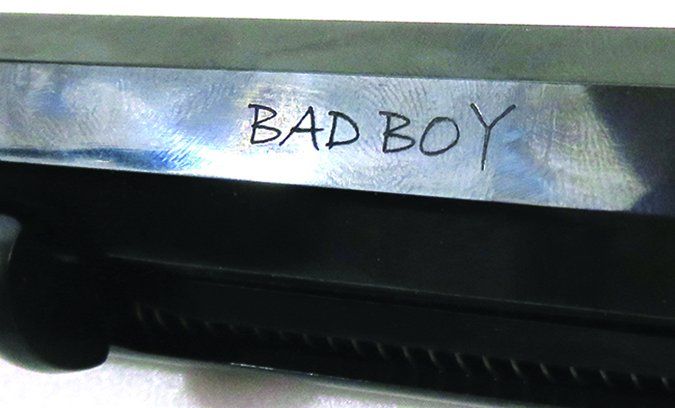
How We Tested
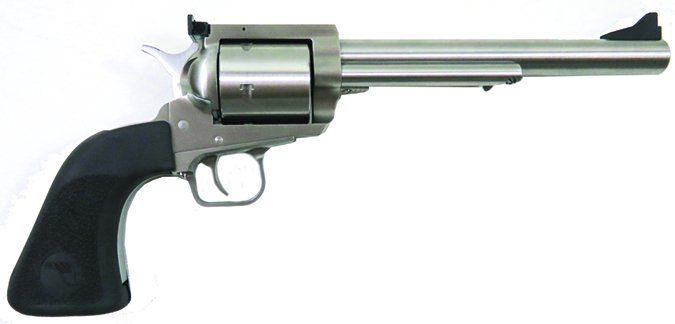
Prior to testing, we ran range rods down the barrel to check chamber and bore alignment and found everything was in spec on all three revolvers. Because the 44 Special cartridge can be fired in revolvers chambered in 44 Magnum, we tested all three with Hornady’s Critical Defense 44 Special ammo loaded with a 165-grain FTX bullet. For 44 Magnum loads, we chose one of our long stand-by rounds from Black Hills loaded with a 240-grain JHP and a newer load from SIG loaded with a 240-grain V-Crown JHP. All rounds provided excellent accuracy.
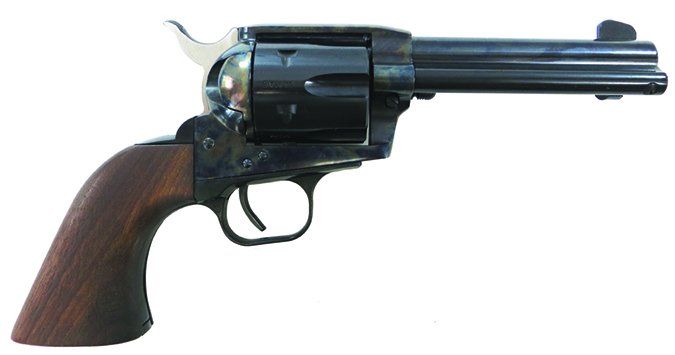
Because the EAA had fixed sights and the BFR and Cimarron had adjustable sights, we leveled the playing field and tested the EAA at 15 yards and the BFR and Cimarron at 25 yards. The sight picture with the adjustable-sight revolvers was far superior than the sight picture with the fixed sights, though the fixed sights of EAA were a modern take on the classic fixed sights. The EAA and BFR were also drilled and tapped to mount a scope. Here’s what we found out about each handgun:
BFR Short Cylinder BFR44MAG7 44 Magnum, $1184
GUN TESTS GRADE: A
The BFR is a well made, heavy revolver that we found to be accurate, has manageable recoil, and can mount a scope.

| ACTION TYPE | Single, hammer cocked |
| OVERALL LENGTH | 13.75 in. |
| BARREL LENGTH | 7.5 in. |
| SIGHT RADIUS | 10.25 in. |
| OVERALL HEIGHT | 6 in. |
| MAX WIDTH | 1.75 in. |
| WEIGHT UNLOADED | 4.8 lbs. |
| WEIGHT LOADED | 5 lbs. |
| CYLINDER GAP | 0.003 in. |
| CAPACITY | 5 |
| FRAME FINISH | Bright stainless |
| BARREL/CYLINDER FINISH | Bright stainless |
| FRAME FRONT STRAP HEIGHT | 3 in. |
| FRAME BACK STRAP HEIGHT | 4.25 in. |
| GRIP | Textured rubber |
| GRIP THICKNESS (max) | 1.4 in. |
| GRIP CIRCUMFERENCE (max) | 5.75 in. |
| FRONT SIGHT | Ramped blade |
| REAR SIGHT | Adjustable rear |
| TRIGGER PULL WEIGHT (SA) | 3.2 lbs. |
| SAFETY | Transfer bar |
| WARRANTY | Limited one year |
| TELEPHONE | (218) 746-3459 |
| WEBSITE | MagnumResearch.com |
| MADE IN | USA |
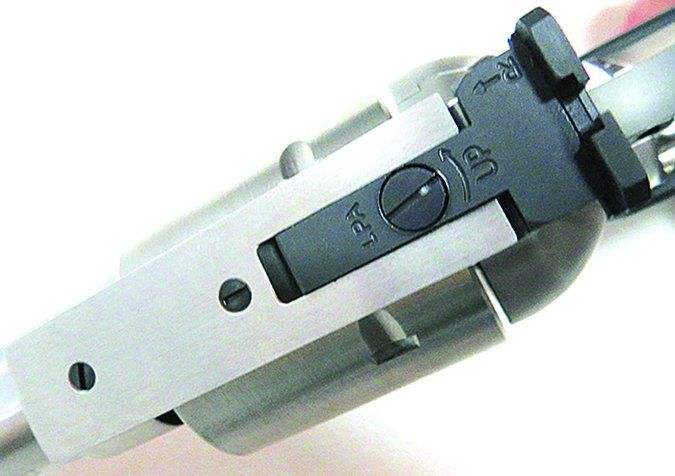
Out of the box, we could tell the BFR was a well-made revolver. It was tight with no wiggle. BFR revolvers come in two model types, a Long Cylinder model for rifle cartridges and .410 shells, and a Short Cylinder model for pistol calibers. BFR revolvers are part of the Magnum Research brand, which is owned by Kahr. This heavy, stainless steel five-shooter wore a bright stainless finish and a large rubber grip manufactured by Hogue. The grip slips over the grip frame and offers a secure hold and helped absorb recoil, since it covers the steel back strap. The side panels had texture, and the grip flared like a typical single action at the butt. We liked the grip. Our test sample sported a 7.5-inch barrel. The front sight is screwed onto the barrel and can be replaced with other blades, a feature we liked. The rear sight was adjustable for windage and elevation, and the adjustment screws were clearly marked. The back side of the rear sight was serrated to cut glare. Sights were a matte-black finish.
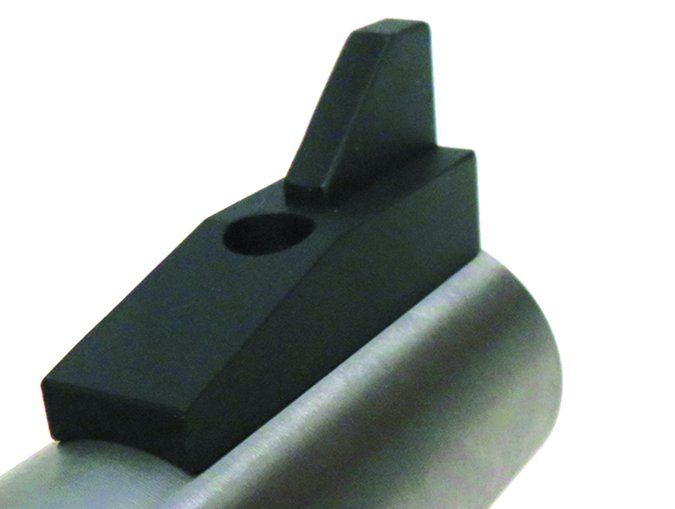
The top strap was also drilled and tapped so a scope mount could be added. We expected this feature to appear because other big-bore single actions, such as the Ruger Super Blackhawk, offer this feature. We think the BFR would do well set up with a scope for hunting. You will need a shoulder holster to tote this heavy hitter around since it is a large revolver.
The Big Frame Revolver mechanism is quite different from the traditional single-action works. The BFR’s hammer has two positions: full forward and full rear. To load the BFR, the hammer must be fully to the rear so the loading gate can be opened. We found the loading gate required a bit more strength to open compared to a traditional single action, but this was no deal breaker. We liked the reverse indexing cylinder, which allows the user to rotate the cylinder both ways. If you rotate too much and miss the chamber, you can just turn the cylinder backward instead of rotating it all the way around. A transfer bar is incorporated into the mechanism, which allows the user to carry the single action fully loaded.
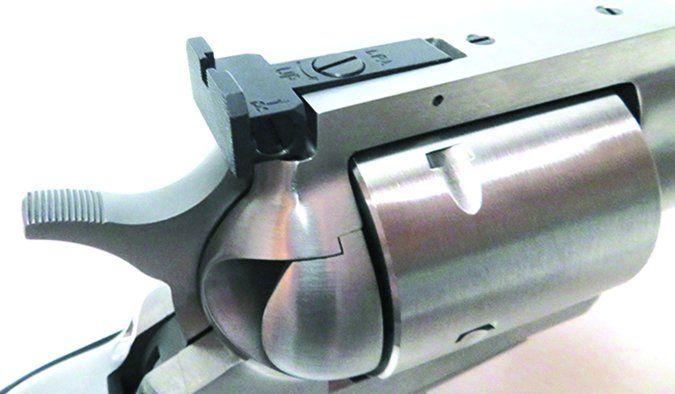
Field-stripping requires a flat-blade screwdriver. First, make sure the hammer is not cocked and is in the fully forward position, then open the loading gate. Use the screwdriver to unscrew the cylinder-pin screw four turns and withdraw the cylinder pin. The cylinder can then be removed from loading gate side of frame. We found the BFR to have a tight fit, and the cylinder-barrel tolerance was 0.003 inch, which is tight. We also discovered the BFR had higher velocities than the Cimarron, which sports an 8-inch barrel. In some cases, the muzzle velocity was 100 fps higher.
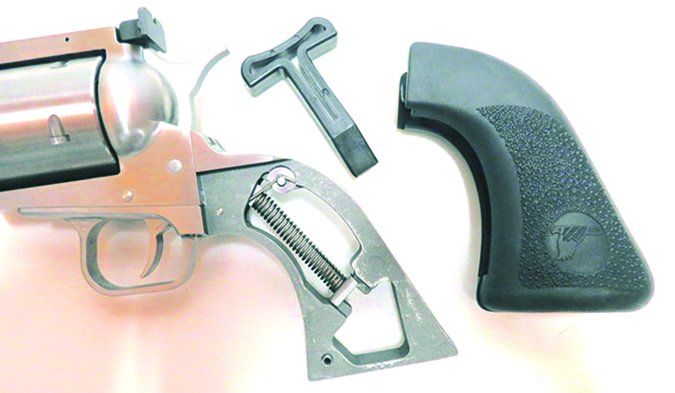
The BFR is equipped with a coiled spring mainspring, similar to a Ruger single action. The trigger was nice and crisp at 3.2 pounds, which helped us shoot some tight groups. The trigger was wider than a typical single action, more like a Ruger trigger. The edges and shape of the trigger were a bit sharp, but that is a small complaint.
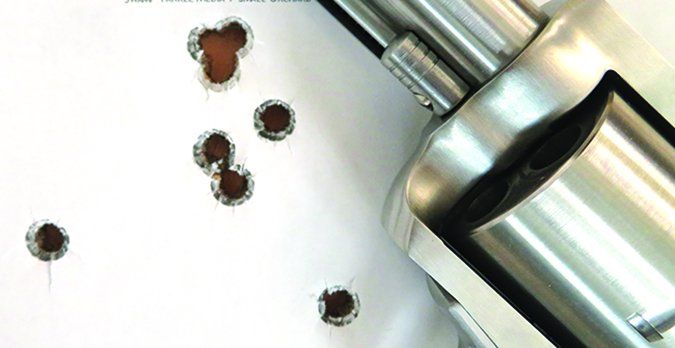
We expected the heft of this revolver and grip to help mitigate recoil, and they did. Shooting 44 Special loads caused mild recoil, and one tester was able to shoot a 1.2-inch 5-shot group. Moving up to 44 Magnum ammo, we found recoil was tolerable because the gun curled back in the shooter’s hand after firing and was so positioned that it was easy to recock the hammer to fire the next round. We did notice that it was best to grip the BFR with the support hand under the trigger guard. If we did not grip it this way, our knuckles were rapped by the sharp edges of the trigger guard during recoil. Average groups with 44 Magnum ammo measured 2 inches. We attribute that to the nice trigger and large sights. We think highly of this BFR, especially after calling our shots at clumps of dirt in the berm at 50 yards.
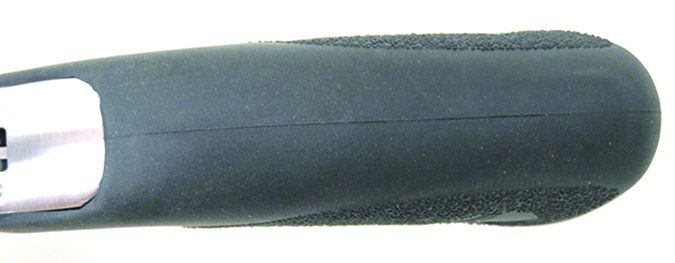
Most empties fell free using a gravity assist, but some needed to be shucked using the ejector rod, which worked as designed.
Our Team Said: The BFR is hefty, and that, we felt, was an asset toward mitigating recoil compared to lighter revolvers. Accuracy was good. We would add a scope and mount and set this revolver up for whitetail deer and boar hunting without a second thought.
EAA Bounty Hunter 770080 44 Magnum, $520
GUN TESTS GRADE: B+
The Bounty Hunter had good accuracy and easy recoil management. The shorter barrel meant the Bounty Hunter could be carried with ease and serve double duty in Cowboy Action Shooting. The trigger was too heavy, in our opinion, and it did not shoot to point of aim, so Kentucky windage was required.
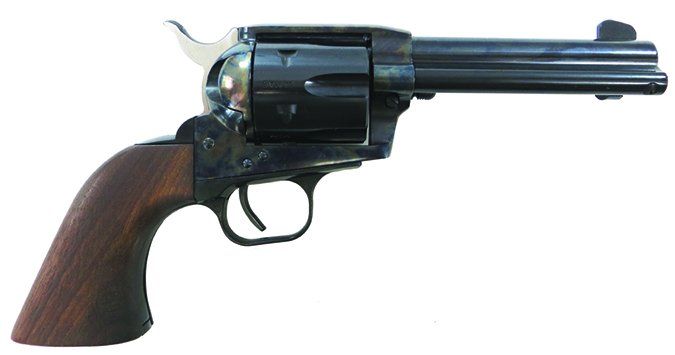
| ACTION TYPE | Single, hammer cocked |
| OVERALL LENGTH | 10 in. |
| BARREL LENGTH | 4.5 in. |
| SIGHT RADIUS | 5.6 in. |
| OVERALL HEIGHT | 5.3 in. |
| MAX WIDTH | 1.7 in. |
| WEIGHT UNLOADED | 38.4 oz. |
| WEIGHT LOADED | 42.6 oz. |
| CYLINDER GAP | 0.004 in. |
| CAPACITY | 6 |
| FRAME FINISH | Blued |
| BARREL/CYLINDER FINISH | Blued |
| FRAME FRONT STRAP HEIGHT | 2.2 in. |
| FRAME BACK STRAP HEIGHT | 3 in. |
| GRIP | Smooth wood |
| GRIP THICKNESS (max) | 1.5 in. |
| GRIP CIRCUMFERENCE (max) | 4.6 in. |
| FRONT SIGHT | Fixed blade |
| REAR SIGHT | Fixed groove |
| TRIGGER PULL WEIGHT (SA) | 7 lbs. |
| SAFETY | Internal transfer bar |
| WARRANTY | Limited lifetime |
| TELEPHONE | (321) 639-4842 |
| WEBSITE | EAACorp.com |
| MADE IN | Germany |
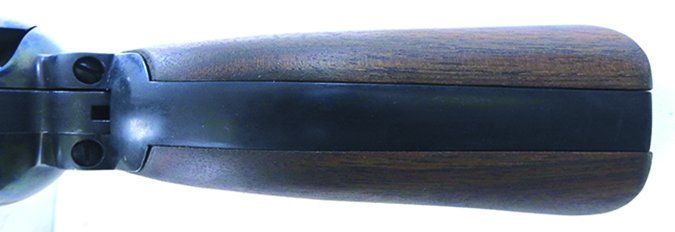
The Bounty Hunter is a German-made six-shooter that takes design cues from classic Colt single action. EAA Corp. imports these six-shooters from Weihrauch, which has been making revolvers more than 20 years. We found the Bounty Hunter to have classic Western looks with fixed sights, classic grip and finish, plus with added safety features built in. It uses a transfer bar system that keeps the hammer from striking the firing pin except when the hammer is fully cocked and the trigger is pulled completely to the rear. You can load all six chambers and safely carry the gun. No need to rest the hammer on an empty chamber. It also comes with a safe-storage security option consisting of an odd hole in the trigger guard. When used with a small padlock, it securely disables the revolver. The traditionalists did not like the transfer bar safety system, but the realists in the test group appreciated the safe-carry characteristics.
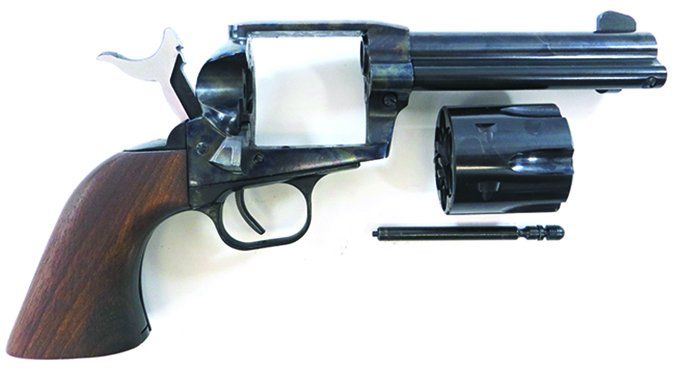
The Bounty Hunter is equipped with a traditional flat mainspring. The trigger was a bit heavy at 7 pounds, but it was serviceable. The edges and shape of the trigger were not exactly like a Colt-style single action, so some of us had to get used to the trigger. The trigger is slightly wider than on a traditional single action.
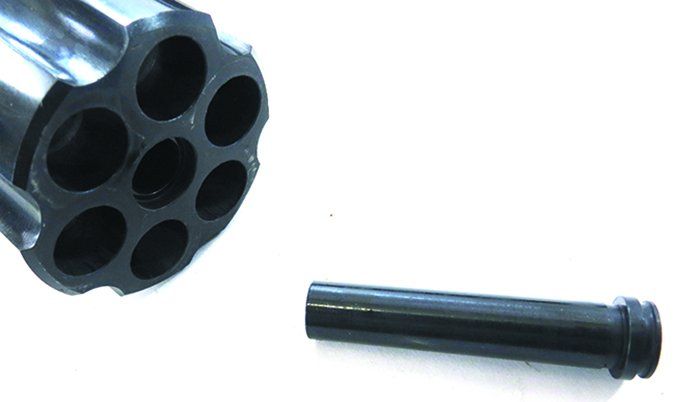
Our sample Bounty Hunter had a 4.75-inch barrel, which we thought was the perfect size for toting in the backcountry or for cowboy-action shooting. Built with a heavy steel frame, the Bounty Hunter is designed to tolerate the substantial recoil generated by the 44 Magnum. At 38.4 ounces, the revolver has plenty of heft, plus the shape of the classic Colt single-action grip makes the revolver curl up in your hand when fired.
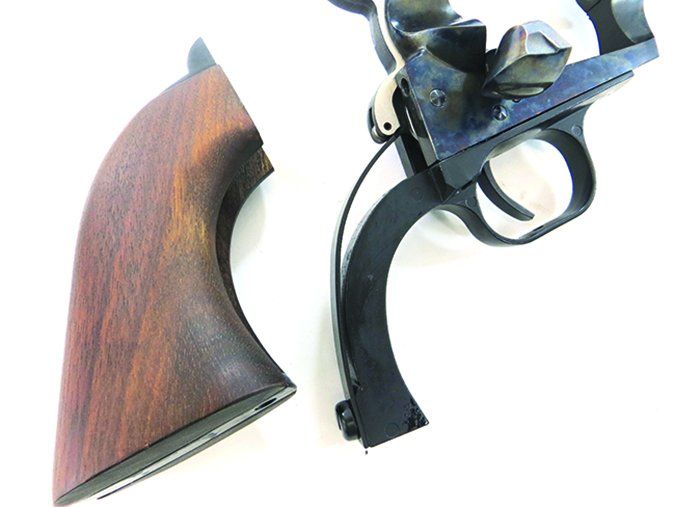
The barrel, ejector rod housing, cylinder, and trigger have a blued finish, while the back strap and trigger guard have a slightly blacker finish. The frame is a dark case hardening with hints of blue, bronze, and purple. The sides of the hammer are left in the white, and the spur was checkered for a sure thumb grip when cocking. Overall, the revolver has a smart look, if not exactly traditional. The smooth satin-finish walnut grip could have been fitted to the grip frame better, as there was a slight overlap on the interior front strap.
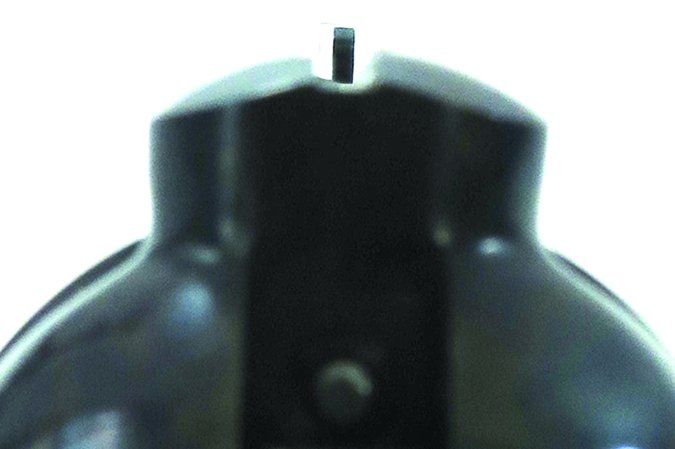
The Bounty Hunter loads similarly to a classic single action. First, cock the hammer halfway back, then open the loading gate to rotate the cylinder and load cartridges. The chambers are recessed in the cylinder, so you can’t see the cartridge rim like on a traditional single action, but there is no need since the Bounty Hunter can be fully loaded. Markings on the barrel are discreetly hidden on the underside along with the chambering. The sights are fixed with a blade front and groove milled in the top of the frame — pure cowboy style. The serial number is stamped on the frame next to the trigger guard like on traditional single-action revolvers. The cylinder also is marked with the caliber and the manufacturer’s initials: HWM. The ejector-rod head is crescent shaped, and it pivots away from the barrel when in use, so your fingertip does not get burned from a hot barrel.
It disassembles by placing the revolver on half cock, opening the loading gate, pressing the base pin, and pulling cylinder pin. The cylinder can then be removed from the loading side of the revolver.
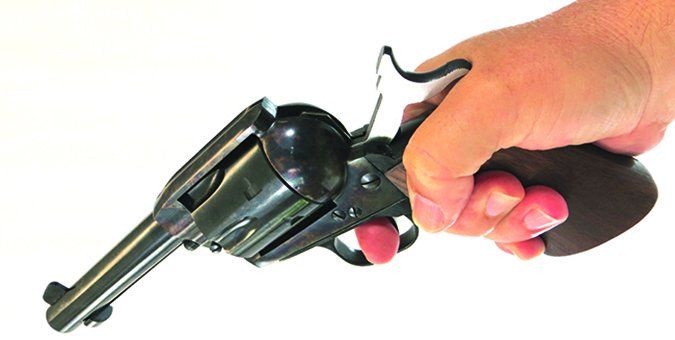
For leather, we used a Hunter Leather classic double-loop holster ($109.45) and matching belt ($101.45). The holster is based on authentic Old West designs and is made from a single piece of leather and hand formed to fit large-caliber single-action revolvers. A rawhide hammer thong keeps it in place. The matching drop belt features a nickel-plated buckle and loops for 45-caliber cartridges, which also fit 44 Special and 44 Magnum rounds.
You can dry-fire the Bounty Hunter, and we did that to work out the initial stiffness in the action. The flat top of the front sight made shooting the Bounty Hunter easier and the flat thickness and the groove were big and bold. The 44 Special loads were pleasant to shoot in the six-shooter, and as anticipated, the 44 Magnum loads had plenty of recoil that was tolerable as the revolver curled in the hand. One tester could get 5-shot groups just under 2 inches. We had to use a bit of Kentucky windage to zero it, but it was a good shooter, with most 5-shot groups at 15 yards measuring on average about 2 inches using a rest. Offhand groups opened up, mainly due to the heavy trigger. Most cases fell free from the chambers when unloading, but a few times the ejector rod was needed to push out a stuck one.
What our shooters liked about the Bounty Hunter is the ability to use it in cowboy-action shooting, plinking, short-range hunting, bear defense, and open or concealed carry. It is a nice, handy size, at an affordable price and you can shoot it loaded up or down.
Our Team Said: The Bounty Hunter is a smart looking, affordable single action in a potent caliber. The trigger could have been better, and we did have to use Kentucky windage. Still, it’s not bad for a 44 Magnum revolver with a retail price of about $500.
Cimarron Bad Boy Model CA360-Bad Boy 44 Magnum, $687
GUN TESTS GRADE: A
The Bad Boy offers a classic single action with a modern twist by using a Colt 1860 Army-style grip and octagonal barrel.
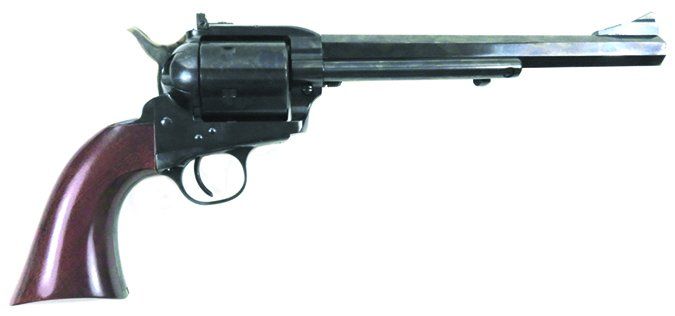
| ACTION TYPE | Single, hammer cocked |
| OVERALL LENGTH | 13.75 in. |
| BARREL LENGTH | 8 in. |
| SIGHT RADIUS | 9.5 in. |
| OVERALL HEIGHT | 5.5 in. |
| MAX WIDTH | 1.6 in. |
| WEIGHT UNLOADED | 2.75 lbs. |
| WEIGHT LOADED | 2.97 lbs. |
| CYLINDER GAP | 0.005 in. |
| CAPACITY | 5 |
| FRAME FINISH | Blue |
| BARREL/CYLINDER FINISH | Blue |
| FRAME FRONT STRAP HEIGHT | 2.37 in. |
| FRAME BACK STRAP HEIGHT | 4.5 in. |
| GRIP | Smooth wood |
| GRIP THICKNESS (max) | 1.45 in. |
| GRIP CIRCUMFERENCE (max) | 5 in. |
| FRONT SIGHT | Ramped blade |
| REAR SIGHT | Adjustable rear |
| TRIGGER PULL WEIGHT (SA) | 3 lbs. |
| SAFETY | None |
| WARRANTY | 5-year limited |
| TELEPHONE | (800) 264-4962 |
| WEBSITE | Cimarron-Firearms.com |
| MADE IN | Italy |
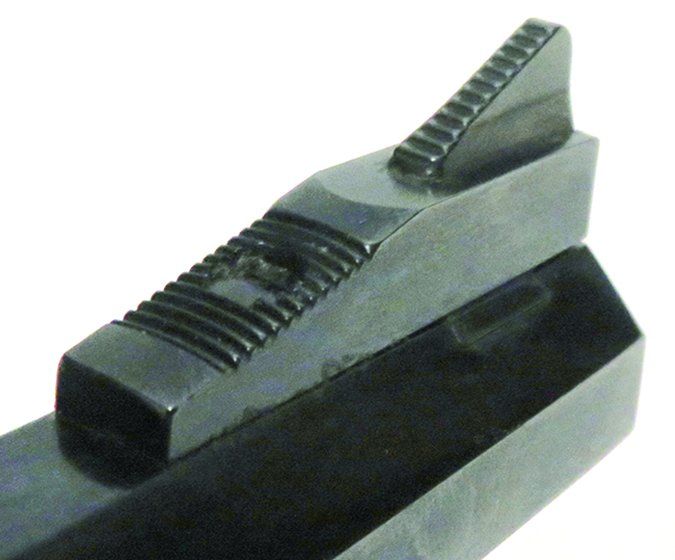
While the EAA and BFR featured modern mechanisms, the Cimarron Bad Boy used a traditional single-action mechanism. The firing pin is located in the hammer, and to safely carry the Bad Boy, you need to rest the hammer on an empty camber. It also loaded like a traditional single action. The hammer needed to be at half cock, open the loading gate, and insert rounds into the chamber. If you rotated the chamber too much, you needed to rotate the cylinder around to get back to that chamber. The Bad Boy is made by Uberti to Cimarron’s specifications.
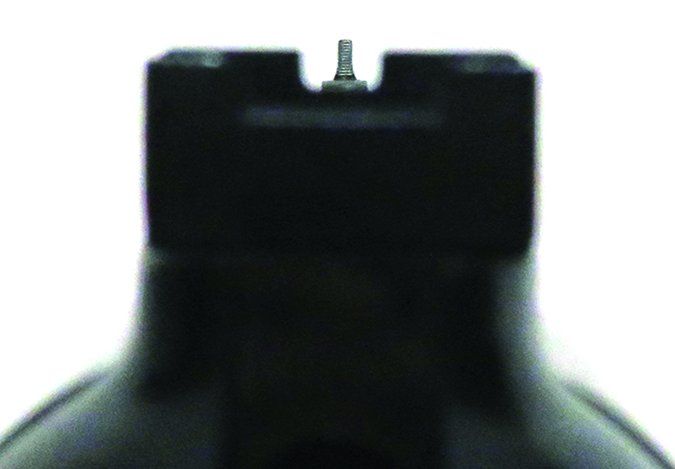
The blued finish was well executed, and there were not sharp edges on the trigger guard. The trigger was skinny like a traditional single action. The trigger broke just under 3 pounds, and that helped with accuracy testing. The Bad Boy is built on a pre-war frame with an 1860 Army-style grip that is longer and thinner than a traditional single action. The two-piece walnut grip is smooth and well fitted to the frame. An 8-inch octagonal barrel and non-fluted cylinder give the Bad Boy a distinct look. The ejector rod uses a crescent-style head that tilts away from the barrel so your fingers don’t get burned from a hot barrel.
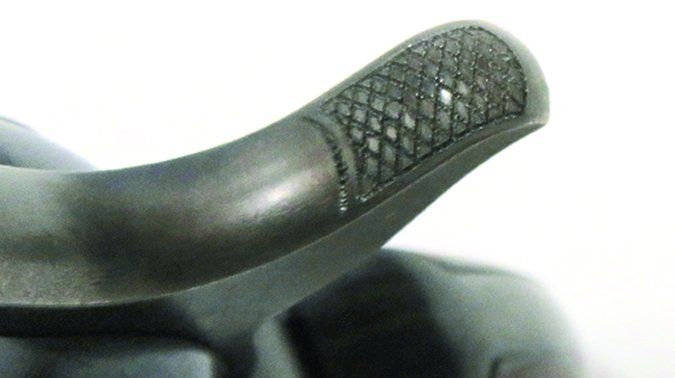
The name Bad Boy is etched in the side of the barrel as if someone scratched it into the steel. Luckily, it is hard to see. The frame is a flat-top style with a ramped front sight that is screwed and dovetailed into the barrel. The ramp is serrated, so there is no sun glare with sights. The rear sight is adjustable for windage and elevation. We like the rear sight on the BFR better, but the Cimarron rear sight was good, and our groups proved that.

The Cimarron is drilled and tapped for a scope, and we were sure it would make a good hunting revolver. We tended to like the BFR better for hunting because of its extra weight, better muzzle velocity, and safety features, which allowed it to be safely carried fully loaded.
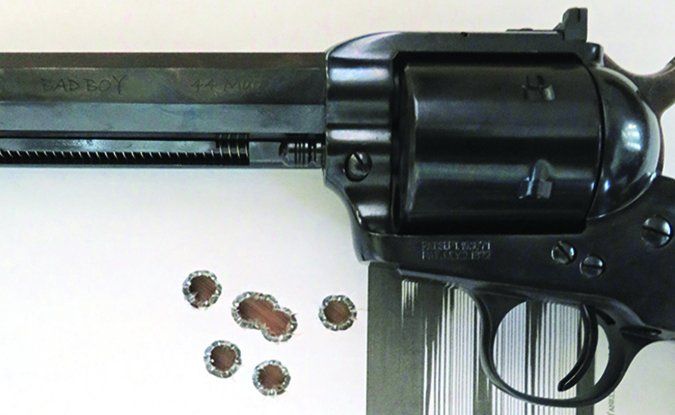
Compared to the BFR, the Cimarron was a lightweight, and we anticipated felt recoil to increase. What we found is the Cimarron curled in our grip and the recoil was quite manageable. With the Hornady Critical Defense 44 Special ammo, one team member was able to shoot a 0.9-inch 5-shot group.
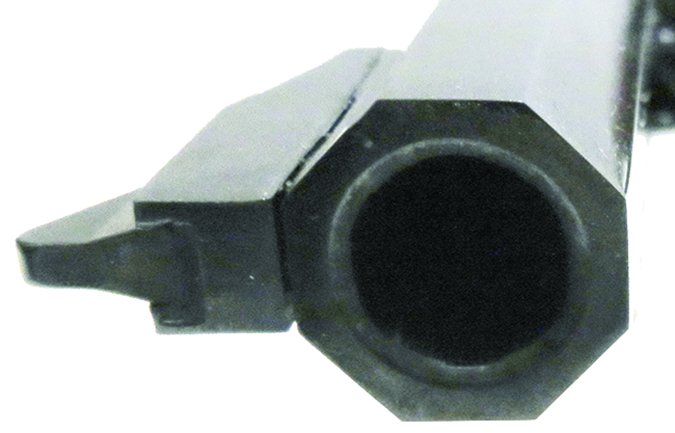
With all three revolvers, we were able to cluster holes. It was easier to shoot those tight groups with the BFR and Cimarron due to the sights and nice triggers. We liked this revolver, and with 44 Magnum ammo, it was easy to average a little over 2-inch groups. With the Cimarron, we didn’t need arm muscles like a Navy SEAL like we did with the BFR.
Our Team Said: There is a lot to like about the Bad Boy, including its accuracy, light weight, and manageable recoil. The longer grip made shooting 44 Magnum rounds pleasant. If we were trekking in bear country, we’d opt for the Bad Boy over the BFR due to former’s lighter weight.
Special thanks to Eastern Outfitters of Hampstead, NC, for their assistance.
Written and photographed by Robert Sadowski, using evaluations from Gun Tests team testers.

























